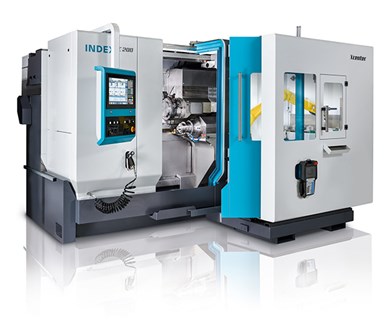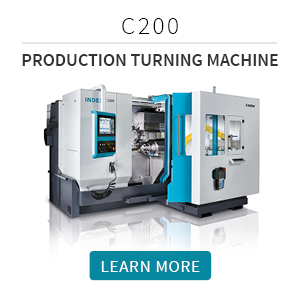Using Advanced CNC Technology to Overcome Labor Shortages
Sponsored ContentMany technology innovations in CNC machine tools can ease the burden of the skills gap, including the CNC lathes and multi-spindle machines from INDEX.
In the most recent skills gap study conducted by Deloitte and The Manufacturing Institute, it is estimated that the number of unfilled manufacturing positions will grow to 2.4 million over the next decade. There are only so many solutions to this challenge, one of which is adopting technologies and processes that enable sales growth with the same number of workers or fewer. This approach has been one of the chief focuses of INDEX, which has developed several technologies designed to enable manufacturers to accomplish more with the labor they already have.
At the surface level, producing more with a static workforce requires some combination of increasing output per machine and/or reducing labor hours per machine. The former means boosting machine utilization, reducing cycle times and moving to a product mix with higher profit margins. The latter covers reductions to setup times, minimizing manual intervention in the production process and incorporating automation for lights-out operations. Shops with aggressive growth plans for the future would do well to identify and pursue those that offer the largest potential upside for their operations.
Redefining Part Production with Advanced Multi-Spindle Technology
Investing in advanced manufacturing technology provides one of the most dramatic improvements a shop can make to its output per operator. INDEX has seen this most frequently among customers who adopt multi-spindle technology to replace Swiss-type machines.

An interior view of the MS40-8 multispindle machine from INDEX.
For many shops, Swiss becomes synonymous with ‘small parts,’ with no consideration of whether the length-to-diameter ratio requires machining on a Swiss-type machine. INDEX estimates that roughly 40% of parts processed on Swiss-type machines in the U.S. could be more productively produced on another type of machine. When these types of parts are moved to a multi-spindle machine, the results can be staggering.

To offer one such real world example, a shop had been using Swiss-type machines to produce a 0.571" (14.5-mm) long bone screw fitting from 0.591"-diameter (15 mm) titanium bar stock. The part required turning, drilling, thread-milling and milling operations. Moving the part to an 8-spindle machine in INDEX’s MS Series enabled one machine to replace six, substantially reducing the labor requirements per part. Beyond that, cycle time dropped by 82% and machine cost per piece decreased by 36.4%, despite the higher cost of the machine.
Not every shop is in a position to adopt a multi-spindle machine or other radically different approaches to processing parts, but for those looking to continue to grow in the coming years, such opportunities must be routinely sought out and evaluated.
Recognizing the Value of Incremental Improvements in CNC Turning
While investing in advanced technologies typically provides larger and flashier improvements, purchasing decisions for more traditional machines also have a significant impact. INDEX sees this play out on a regular basis via the C Series of production turning centers.

While the C100 and C200 machines may appear similar to other high-end lathes on the market, the machines incorporate a variety of proprietary design elements such as the SingleSlide guide system. Most of these features increase the speed of the machines’ movements. For example, the design of the turrets enables chip-to-chip indexing times that are 1-to-2 seconds faster than most competing machines.
Taken on its own, a 1-second reduction in indexing time sounds insignificant, but the aggregate impact on throughput is substantial. Consider a part with a 90-second cycle time that requires indexing the turret 12 times. That seemingly slight, 1-second improvement in this common movement shrinks cycle time to 78 seconds, a reduction of 13.3%. For a machine running two shifts at 90% utilization, that 1-second improvement boosts annual capacity from 144,000 pieces to 166,154 pieces.
Speed isn’t the only factor that will have an impact. Small differences in reliability, maintenance requirements, ease of setup and more will all directly influence the quantity of a machine’s output, as well as the amount of labor it consumes to produce at that level. Taking these differences into consideration will help expand your growth potential.
Investing in Integrated Automation for CNC Machines
Automation has been a highly effective means to increase output per operator. For years, many machine tool builders have been willing to work with a provider of automation equipment or third party integrator to develop and deliver turnkey solutions. Now, some builders are beginning to offer standard, integrated options that incorporate automation built directly into the machine. The iXcenter robotic cell from INDEX incorporates this approach.

Fully integrated with the C100, C200 and TNL20 machines, iXcenter occupies minimal floorspace, requires no additional expertise to operate and provides operators with an ergonomic and easy-to-use solution. While fixed in front of the work area during machining, the cell conveniently slides aside to allow operator access to the workspace.
Housing up to 22 pallets with a minimal pallet height of 25.4 mm, iXcenter can hold a significant quantity of blanks and/or finished parts. The construction of the system allows an operator to load blanks or unload parts from the cell without interrupting the machining processes, further contributing to high utilization rates. Additionally, the cell includes space to incorporate a secondary process, such as deburring, cleaning or measuring.
With an effective automation solution, shops can reduce labor hour per machine by up to 75%, while also achieving reliable lights out production to make parts overnight and on weekends. The simplicity of iXcenter is making it easier than ever to attain this benefit.
Moving Process Optimization off the Machine
Frequently, manufacturers view small steps toward optimization as not worth the interruption to production. In some instances, advancements in software have eliminated this trade-off and made it easy to identify, evaluate and implement incremental improvements with no downtime at the machine.
INDEX’s Virtual Machine simulation software is a powerful tool for continuous improvement efforts. Each copy of Virtual Machine is as unique as the machine it reflects, as the software is fully customized to reflect the options and build-out selected by a shop. As a result, programming in Virtual Machine is indistinguishable from programming the actual machine and workpieces will run exactly the same as their simulated counterparts. This allows off-machine refinements that further enhance the efficiency of a shop’s labor.

A screenshot of INDEX’s Virtual Machine in action.
Organizational Transformation through Industry 4.0
Last, but far from least, Industry 4.0 should be an integral consideration for any company navigating the skilled labor gap and looking to develop a future growth plan. The centralization of data from an entire production environment allows for a far more efficient deployment of labor.
In a fully networked facility, real-time machine status coupled with predefined condition notifications help to minimize the amount of time operators spend at machines. Additionally, the incorporation of predictive maintenance plans enables far more efficient scheduling. Furthermore, robust utilization and process analysis identifies bottlenecks and opportunities to eliminate them. Finally, a holistic view of a facility contributes to a company’s agility, allowing for faster and more effective responses to the unexpected.
INDEX has created a versatile package of Industry 4.0 tools and functionalities called iX4.0. Secure and reliable, this package connects the machine to a company’s network and provides troves of valuable data on its status and performance, as well as facilitates the analysis of that data to gain insight.
In the coming years, the industry will hit a tipping point where the use of networked data ceases to be a competitive advantage and becomes a standard prerequisite for survival. Taking first steps today will help shops continue to thrive in the future.
In Conclusion
If you have not already felt the pinch of the skilled labor shortage, chances are that you will soon. Walk your production floor and take a quick count of how many of your team members will be retiring in the next decade. Continuing to successfully grow will require multiple actions, both to develop your future workforce, as well as empower them to produce more than ever before. To learn more about how advanced turning centers and technology from INDEX can help you achieve this, visit index-usa.com or email them at sales@index-usa.com.


